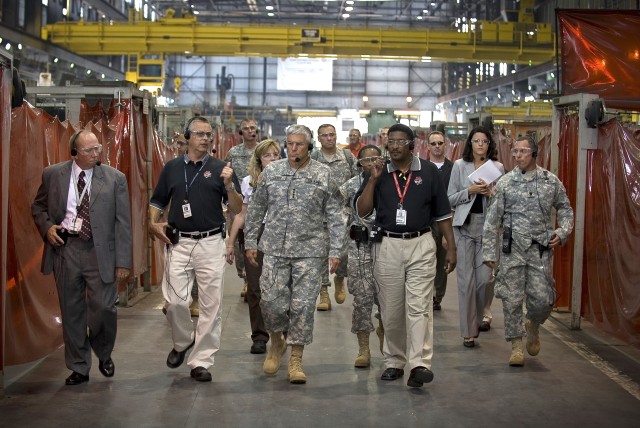
ANNISTON ARMY DEPOT, Ala.-U.S. Army Chief of Staff Gen. George Casey said the last time he visited the depot was in the 1980s, and he noted that was when Rep. Bill Nichols, the namesake of the depot's industrial complex, was working on Capitol Hill.
"It was like the Stone Age compared to now," said Casey, referring to the improvements made over 20 years to the processes and capabilities inside the 5-acre Stanley Maintenance Facility that has housed teardown and rebuild of war-worn combat vehicles for more than 50 years.
Casey, the highest ranking general in the Army, stopped by the depot Sept. 18 to see what 7,000-plus Army civilians and contractors were doing in support of the U.S. military and its allies. He was in the state on other business and then went to Atlanta after leaving Alabama.
The general's tour was guided by Depot Commander Col. S. B. Keller and Anniston Chemical Activity, or ANCA, Commander Lt. Col. Andrew Herbst.
The depot is the designated Center of Industrial and Technical Excellence, or CITE, for tracked and wheeled combat vehicles, artillery, bridging systems, and small caliber weapons.
Inside the depot's Stanley Maintenance Facility, combat vehicles like the M1 Abrams, M88, Paladin, and the Field Artillery Ammunition Support Vehicle, or FAASV, are disassembled-some completely, some partially-before their components are sent to support shops across the industrial complex for repair. The parts come back to Stanley to be reassembled.
Casey was interested in the depot's monthly output of tanks that are sent back to the Soldiers. Keller said workers here produce 50 to 65 M1 Abrams tanks a month, an increase in throughput from previous years due largely because the depot is "engrossed in Lean manufacturing and Six Sigma."
Two of Anniston's production processes last year received awards for operational excellence from the Shingo Prize organization, a leading expert of process improvement in the private industry.
"It's all because of leadership," Casey told to a group of shop-floor supervisors.
Keller and Deputy to the Commander Jack Cline not only touted the depot's successes in Lean manufacturing but were also able to show the general how public-private partnering is vital to the Army's sustainment initiatives.
The depot partners with BAE Systems to overhaul the M88 and the M113 vehicles. Honeywell repairs recuperator plates and builds new AGT 1500 engines on the depot.
Defense contractor General Dynamics Land Systems has partnered with Anniston since the early 2000s to build all models of the eight-wheeled Stryker vehicle at a facility on the depot. And, many of the same Strykers have returned from Southwest Asia to be reset. The partners have repaired more than 100 battle- and combat-damaged Strykers.
Anniston is partnering with the U.S. Marine Corps in the production of two new systems-the Assault Breacher Vehicle and the Joint Assault Bridge.
"Partnering is very valuable to these programs and to the Army. The original equipment manufacturers are great at material management and technical support and we're great at vehicle maintenance," said Cline.
Casey also saw the final construction stages of Anniston's new powertrain facility, where workers are expected to begin remanufacturing diesel engines later this year.
ANCA, a depot tenant with its own mission to dispose of chemical munitions, has incinerated close to 50 percent of Anniston's chemical munitions stockpile. It began destroying the stockpile in 2003 and has been incident-free ever since.
Casey got an up-close look at one of ANCA's Enhanced On-Site Containers, or EONC, which is used to transport the munitions from storage igloos to the incinerator.
"Looks like a great operation," said Casey.

Social Sharing